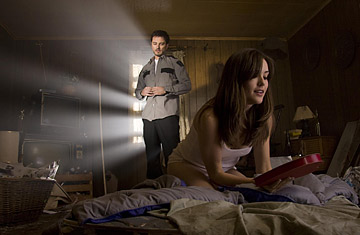
Kerr Smith, left, and Megan Boone star in My Bloody Valentine
(2 of 3)
With the movie (whose actual title is just My Bloody Valentine) being shown in 3-D on more than a thousand screens, director Patrick Lussier and writers Todd Farmer and Zane Smith had to devise some stuff that jumps out at you — like the opening money shot, in which the killer slams a poker through the back of a guy's head and its comes out through his eye, the orb jutting into the audience like the garnish on a kebab skewer. Kudos for that, and for the variations the filmmakers run on the mischief a pickax can work on the human body. (Or a shovel: one victim gets her face sliced through sideways at the mouth, the head sliding slowly down the shovel, everything from the jaw and below dropping out of frame.) Such are the reductive pleasures of horror movies; they turn viewers into connoisseurs of sadism, co-conspirators with the madman performing his miner atrocities. It's what we're here for, right?
Horror movies demand a similarly reduced intelligence from the characters, who must forever be running alone into the woods, walking into crime-scene tunnels or taking a ride with someone quite likely to be the killer. For the genre director, a horror film is a game of geometry. It's all about the slow movement of the victim and the camera into a space of probable peril. In the Hitchcock school of tension-ratcheting, Lussier is an apt apprentice. (He also borrows a Hitchcock trick, from Stage Fright, of showing a misleading scene from the killer's demented point of view.) The movie is nothing above the ordinary, but that doesn't matter to the horror fanboys, who go to these movies the way their dads visit Ace Hardware. Different tools, familiar vibe.
Notorious
His parents were from Jamaica, but Christopher Wallace, a.k.a. the Notorious B.I.G., a.k.a. Biggie Smalls, was straight outta Brooklyn. In the mid-'90s, when the hottest, hardest rap came from California, Biggie restored some bicoastal equilibrium with his quadruple-platinum CD Ready to Die. After that, the headlines were mostly police-blotter stuff. In 1996 his ex-friend, then rival Tupac Shakur was shot and killed in Las Vegas. The following year, when Biggie made an incursion onto L.A. turf to promote his new album, he was shot and killed. (Neither murder was officially solved.) In 2003 Shakur got a zazzy docutribute, Tupac: Resurrection. Now comes Biggie's biopic. It's like the Day the Music Died for rhyming street punks.
Biggie, who was discovered by Sean Combs (then Puff Daddy), flaunted the gangsta-rapper M.O. of drug-dealing, motor-mouthing and subsidiary violence. The movie Biggie (Jamal Woolard) is portrayed sympathetically — sometimes cunning, ruthless and weak, but a gifted, generous man who's surrounded by strong women: his girlfriend-rappers Faith Evans (Antonique Smith) and Lil' Kim (Naturi Naughton) and especially his mother Violetta (Angela Bassett). His ladies provide a few steamy sex scenes; The Lady, Violetta, anchors the story as one of a noble mom demanding that her boy meet the high standards she's set for him. It's worth noting that the director, George Tillman Jr., previously did the femme-family Soul Food — and, even more, that the movie's producers include Combs and Violetta Wallace. They come to praise Biggie. The result is not exposé but eulogy.
